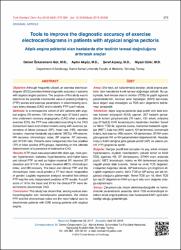Tools to improve the diagnostic accuracy of exercise electrocardiograms in patients with atypical angina pectoris
| dc.contributor.author | Özkaramanlı Gür, Demet | |
| dc.contributor.author | Akyüz, Aydın | |
| dc.contributor.author | Alpsoy, Şeref | |
| dc.contributor.author | Güler, Niyazi | |
| dc.date.accessioned | 2022-05-11T14:40:09Z | |
| dc.date.available | 2022-05-11T14:40:09Z | |
| dc.date.issued | 2018 | |
| dc.identifier.issn | 1016-5169 | |
| dc.identifier.uri | https://doi.org/10.5543/tkda.2018.34358 | |
| dc.identifier.uri | https://hdl.handle.net/20.500.11776/8884 | |
| dc.description.abstract | Objective: Although frequently utilized, an exercise electrocardiogram (ECG) provides limited diagnostic accuracy in patients with atypical angina pectoris. The purpose of this study was to determine the possible incremental value of pretest probability (PTP) scores and exercise parameters in discriminating coronary artery disease (CAD) and to identify PTP cutoff values. Methods: In a retrospective cohort of 207 patients with atypical angina (76 women, 131 men; mean age: 57.6 +/- 8.2 years) who underwent coronary angiography (CAG) after a positive exercise ECG, the PTP was calculated according to the CAD Consortium basic and clinical models along with exercise parameters of blood pressure (BP), heart rate (HR), exercise duration, maximal metabolic equivalents (METs), HR reserve, HR recovery, chronotropic index, BP reserve, BP recovery, and ST/HR ratio. Patients were categorized into true positive (TP) or false positive (FP) groups, depending on the ultimate determination of a presence of obstructive CAD. Results: A TP result was associated with older age, male gender, hypertension, diabetes, hyperlipidemia, and higher basic and clinical PTP, as well as higher maximal BP, maximal ST deviation and ST/HR, but lower maximal METs, chronotropic index, and HR recovery. The basic and clinical PTP, and the chronotropic index could predict a TP test result irrespective of gender. Logistic regression analysis revealed that clinical PTP was the only independent predictor of TP results. A cutoff score of 18 for the basic and 21 for the clinical PTP were determined to discriminate CAD. Conclusion: This study has shown that, among various electrocardiographic and hemodynamic parameters, the clinical PTP and the chronotropic index are the most helpful tools to discriminate patients with CAD among patients with atypical angina. | en_US |
| dc.language.iso | eng | en_US |
| dc.publisher | Aves | en_US |
| dc.identifier.doi | 10.5543/tkda.2018.34358 | |
| dc.rights | info:eu-repo/semantics/openAccess | en_US |
| dc.subject | Coronary artery disease | en_US |
| dc.subject | exercise electrocardiogram | en_US |
| dc.subject | pretest probability | en_US |
| dc.subject | Coronary-Artery-Disease | en_US |
| dc.subject | Guidelines | en_US |
| dc.subject | Management | en_US |
| dc.subject | Update | en_US |
| dc.subject | Probability | en_US |
| dc.subject | Predictor | en_US |
| dc.subject | Score | en_US |
| dc.title | Tools to improve the diagnostic accuracy of exercise electrocardiograms in patients with atypical angina pectoris | en_US |
| dc.title.alternative | Atipik angina pektorisi olan hastalarda efor testinin tanısal doğruluğunu arttıracak araçlar] | en_US |
| dc.type | editorialMaterial | en_US |
| dc.relation.ispartof | Turk Kardiyoloji Dernegi Arsivi-Archives of the Turkish Society of Cardiology | en_US |
| dc.department | Fakülteler, Tıp Fakültesi, Dahili Tıp Bilimleri Bölümü, Kardiyoloji Ana Bilim Dalı | en_US |
| dc.identifier.volume | 46 | en_US |
| dc.identifier.issue | 5 | en_US |
| dc.identifier.startpage | 375 | en_US |
| dc.identifier.endpage | 384 | en_US |
| dc.institutionauthor | Özkaramanlı Gür, Demet | |
| dc.institutionauthor | Akyüz, Aydın | |
| dc.institutionauthor | Alpsoy, Şeref | |
| dc.institutionauthor | Güler, Niyazi | |
| dc.relation.publicationcategory | Diğer | en_US |
| dc.authorscopusid | 55317577700 | |
| dc.authorscopusid | 16315021800 | |
| dc.authorscopusid | 6505680586 | |
| dc.authorscopusid | 7005837198 | |
| dc.authorwosid | Alpsoy, Seref/Z-1808-2018 | |
| dc.identifier.wos | WOS:000446494100022 | en_US |
| dc.identifier.scopus | 2-s2.0-85049916381 | en_US |
| dc.identifier.pmid | 30024394 | en_US |
Bu öğenin dosyaları:
Bu öğe aşağıdaki koleksiyon(lar)da görünmektedir.
-
PubMed İndeksli Yayın Koleksiyonu [1580]
PubMed Indexed Publications Collection -
Scopus İndeksli Yayınlar Koleksiyonu [4328]
Scopus Indexed Publications Collection -
Tıp Fakültesi Koleksiyonu [2104]
-
TR-Dizin İndeksli Yayınlar Koleksiyonu [2795]
TR-Dizin Indexed Publications Collection -
WoS İndeksli Yayınlar Koleksiyonu [4789]
WoS Indexed Publications Collection



















